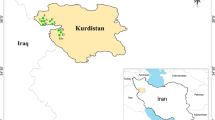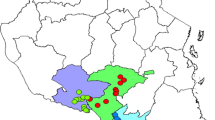Abstract
Several species of Orchidaceae, one of the largest plant families, are considered endangered throughout South America and legal protection policies are needed so they can be preserved. Inter simple sequence repeats (ISSRs) markers are a potential tool to be used in the phylogenetic reconstruction of closely related species. In this study, we evaluate the polymorphic information content (PIC) and optimum number of ISSR markers (ONM) for five Laeliinae orchids in order to assess genetic diversity. The phylogenetic relationships between Cattleya granulosa, an endangered Brazilian orchid, and four other native Brazilian species (Brassavola tuberculata, Cattleya bicolor, Cattleya labiata and Cattleya schofieldiana) were analyzed for genetic diversity and differentiation. The 11 selected primers generated 166 unambiguous loci (PIC = 0.354; ONM = 156). Of the five studied species, C. bicolor exhibited the highest level of genetic diversity (H E = 0.219), while C. labiata exhibited the lowest level (H E = 0.132). The percentage of genetic variation among species (analysis of molecular variance) was 23.26 %. The principal component analysis (PCA) of ISSR data showed that unifoliate and bifoliolate species are genetically divergent. Additionally, PCA indicated a close relation between C. granulosa and C. schofieldiana, a species considered to be a variety of C. granulosa by many researchers. Thus, we conclude that ISSR genetic markers are effective in detecting genetic differentiation among orchid species.


Similar content being viewed by others
References
Allendorf FW, Luikart G (2007) Conservation and the genetics of populations. Blackwell, London, p 642
Arcade A, Anselin F, Faivre Rampant P, Lesage MC, Paques LE, Prat D (2000) Application of AFLP, RAPD and ISSR markers to genetic mapping of European and Japanese larch. Theor Appl Genet 100:299–307
Archibald JK, Mort ME, Crawford DJ, Santos-Guerra A (2006) Evolutionary relationships within recently radiated taxa: comments on methodology and analysis of inter-simple sequence repeat data and other hypervariable, dominant markers. Taxon 55(3):747–756
Ávila-Diaz I, Oyama K (2007) Conservation genetics of an endemic and endangered epiphytic Laelia speciosa (Orchidaceae). Am J Bot 94(2):184–193
Azevedo CO, Borba EL, van den Berg C (2006) Evidence of natural hybridization and introgression in Bulbophyllum involutum Borba, Semir and Barros and B. weddellii (Lindl.) Rchb.f. (Orchidaceae) in the Chapada Diamantina, Brazil, by using allozyme markers. Revista Brasileira de Botânica 29:415–421
Barros F, Vinhos F, Rodrigues VT, Barberena FFVA, Fraga CN, Pessoa EM, Forster W, Menini LN (2013) Orchidaceae in lista de espécies da flora do Brasil. Jardim Botânico do Rio de Janeiro (http://floradobrasil.jbrj.gov.br/jabot/floradobrasil/FB11344)
Borba EL, Felix JM, Solferini VN, Semir J (2001) Fly-pollinated Pleurothallis (Orchidaceae) species have high genetic variability: evidence from isozyme markers. Am J Bot 88:419–428
Braem GJ (1984) Die bifoliaten Catteyen Brasiliens. Brücke-Verlag Kurt Schmersow, Hildesheim, p 94
Braem GJ (1994) William Cattley e o gênero Cattleya. In: Menezes LC (ed) Cattleya warneri. Naturalia Publications, pp 27–31
Brandão MM, Vieira FA, Carvalho D (2011) Estrutura genética em microescala espacial de Myrcia splendens (Myrtaceae). Revista Árvore 35:957–964
Colombo C, Second G, Charrier A (2000) Diversity within American cassava germplasm based on RAPD markers. Genet Mol Biol 23(1):189–199
Cruz CD (2001) Programa GENES: versão Windows. Viçosa: UFV, p 642
Cunha MFB, Forzza RC (2007) Orchidaceae no Parque Natural Municipal da Prainha, RJ, Brasil. Acta Botânica Brasilica 21(2):383–400
Dodson CH, Dressler RL, Hills HG, Adams RA, Williams NH (1969) Biologically active compounds in orchid fragrances. Science 113:1243–1249
Doyle JJ, Doyle JL (1987) A rapid DNA isolation method for small quantities of fresh tissues. Phytochem Bull Bot Soc Amer 19:11–15
Excoffier L, Laval G, Schneider S (2009) Arlequin: a software for population data analysis. Version 3.1. Geneva: University of Geneva, 2007. http://cmpg.unibe.ch/software/arlequin3. Accessed 17 Feb
Govaerts R (2003) World checklist of monocotyledons database in ACCESS: 1-71827. The Board of Trustees of the Royal Botanic Gardens, Kew
Hamrick JL, Godt MJW (1990) Allozyme diversity in plant species. In: Brown AHD, Clegg MT, Kahler AL, Weir BS (eds) Plant population genetics, breeding, and genetic resources. Sinauer Associates, Sunderland, MA, pp 43–63
Hao G, Lee D-H, Lee JS, Lee NS (2002) A study of taxonomical relationships among species of Korean Allium sect. Sacculiferum (Alliaceae) and related species using inter-simple sequence repeat (ISSR) markers. Bot Bull Acad Sin 43:63–68
Hsiao S-C, Huang W-T, Lin M-S (2010) Genetic diversity of Balanophora fungosa and its conservation in Taiwan. Bot Stud 51:217–222
StatSoft Inc. (2004) STATISTICA (data analysis software system), version 7. StatSoft Inc., Tulsa
Jin GG, Naito T, Matsui S (2004) Randomly amplified polymorphic DNA analysis for establishing phylogenetic relationships among Cattleya and its allied genera. J Jpn Soc Hortic Sci 73(6):583–591
Joshi SP, Gupta VS, Agarwal RK, Ranjekar PK, Brar DS (2000) Genetic diversity and phylogenetic relationship as revealed by inter simple sequence repeat (ISSR) polymorphism in the genus Oryza. Theor Appl Genet 100:1311–1320
Kishor R, Devi HS (2009) Induction of multiple shoots in a monopodial orchid hybrid (Aerides vandarum Reichb.f x Vanda stangeana Reichb.f) using thidiazuron and analysis of their genetic stability. Plant Cell Tiss Organ Cult 97:121–129
Kruskal JB (1964) Multidimensional scaling by optimizing goodness of fit to a no metric hypothesis. Psychometrika 29(1):1–27
Lovisa AGS, Verola CF, Antonelli A (2010) Reassessing the temporal evolution of orchids with new fossils and a Bayesian relaxed clock, with implications for the diversification of the rare South American genus Hoffmannseggella (Orchidaceae: Epidendroideae). Evol Biol 10:177
Manly BFJ (1997) Randomization, bootstrap and Monte Carlo methods in Biology. London: Chapman and Hall, p 399
Martinelli G, Moraes MA (2013) Livro vermelho da flora do Brasil. Rio de Janeiro: Andrea Jakobsson: Instituto de Pesquisas Jardim Botânico do Rio de Janeiro, 1st edn
Menezes LC (2002) Cattleya labiata autumnalis. Edições IBAMA, Brasília, p 252
Ministério do Meio Ambiente (2008) Instrução normativa de 23 de setembro 6:55
Mora F, Gonçalves LM, Scapim CA, Martins EN, Machado MFPS (2008) Generalized lineal models for the analysis of binary data from propagation experiments of Brazilian Orchids. Braz Arch Biol Technol 51(5):963–970
Nei M (1973) Analysis of gene diversity in subdivided populations. Proc Nat Acad Sci 70(12):3321–3323
Nei M (1987) Molecular evolutionary genetics. Columbia University Press, New York
Nybom H, Bartish I (2000) Effects of life history traits and sampling strategies on genetic diversity estimates obtained with RAPD markers in plants. Perspect Plant Ecol Evol Syst 3(2):93–114
Phillips RD, Dixon KW, Peakall R (2012) Low population genetic differentiation in the Orchidaceae: implications for the diversification of the family. Mol Ecol 21:5208–5220
Pinheiro F, de Barros F, Palma-Silva C, Meyer D, Fay MF, Suzuki RM, Lexer C, Cozzolino S (2010) Hybridization and introgression across different ploidy levels in the Neotropical orchids Epidendrum fulgens and E. puniceoluteum (Orchidaceae). Mol Ecol 19:3981–3994
Pinheiro LR, Rabbani ARC, Silva AVC, Lédo AS, Pereira KLG, Leandro Diniz LEC (2012) Genetic diversity and population structure in the Brazilian Cattleya labiata (Orchidaceae) using RAPD and ISSR markers. Plant Syst Evol 298:1–11
Reddy MP, Sarla N, Siddiq EA (2002) Inter simple sequence repeat (ISSR) polymorphism and its application in plant breeding. Euphytica 128:9–17
Sneath PHA, Sokal RR (1973) Numerical taxonomy. Freeman, San Francisco
Storti EF, Braga PIS, Filho AS (2011) Biologia reprodutiva de Cattleya eldorado, uma espécie de Orchidaceae das campinas amazônicas. Acta Amaz 41(3):361–368
Sudupak MA (2004) Inter and intra-species inter simple sequence repeat (ISSR) variations in the genus Cicer. Euphytica 135:229–238
van den Berg C, Higgins WE, Dressler RL, Whitten WM, Soto Arenas MA, Culham A, Chase MW (2000) A phylogenetic analysis of Laeliinae (Orchidaceae) based on sequence data from internal transcribed spacers (ITS) of nuclear ribosomal DNA. Lindleyana 15(2):96–114
van den Berg C, Higgins WE, Dressler RL, Whitten WM, Soto-Arenas MA, Chase MW (2009) A phylogenetic study of Laeliinae (Orchidaceae) based on combined nuclear and plastid DNA sequences. Ann Bot 104:417–430
Verma PC, Chakrabarty D, Jena SN, Mishra DK, Singh PK, Sawant SV, Tuli R (2009) The extent of genetic diversity among Vanilla species: Comparative results for RAPD and ISSR. Ind Crops Prod 29:581–589
Wang H-Z, Wu Z-X, Lu J-J, Shi N-N, Zhao Y, Zhi-Tao Zhang Z-T, Liu J-J (2009a) Molecular diversity and relationships among Cymbidium goeringii cultivars based on inter-simple sequence repeat (ISSR) markers. Genetica 136:391–399
Wang H-Z, Feng S-G, Lu J-J, Shi N-N, Liu J-J (2009b) Phylogenetic study and molecular identification of 31 Dendrobium species using inter-simple sequence repeat (ISSR) markers. Sci Hortic 122:440–447
Wang H-Z, Lu J-J, Hu X, Liu J-J (2011) Genetic variation and cultivar identification in Cymbidium ensifolium. Plant Syst Evol 293(1):101–110
World Checklist of Monocotyledons (2006) The board of trustees of the Royal Botanic Gardens, Kew. (www.kew.org). Acesso em Dec 7, 2011
Yeh FC, Yang RC, Boyle TBJ, Ye ZH, Mao JX (1999) POPGENE, the user friendly shareware for population genetic analysis, version 1.31. University of Alberta and Centre for International Forestry Research
Zhang F, Lv Y, Dong H, Guo S (2010) Analysis of genetic stability through intersimple sequence repeats molecular markers in micropropagated plantlets of Anoectochilus formosanus Hayata, a medicinal plant. Biol Pharm Bull 33(3):384–388
Zhang CS, Xing FG, Selvaraj JN, Yang QL, Zhou L, Zhao YJ, Liu Y (2013) The effectiveness of ISSR profiling for studying genetic diversity of Aspergillus flavus from peanut-cropped soils in China. Biochem Syst Ecol 50:147–153
Zietjiewicz E, Rafalski A, Labuda D (1994) Genome fingerprinting by simple sequence repeat (SSR)-anchored polymerase chain reaction amplification. Genomics 20:176–183
Acknowledgments
The authors acknowledge the Brazilian agency “Coordenação de Aperfeiçoamento de Pessoal de Nível Superior (CAPES)” for providing a PhD fellowship to C.G. Fajardo. We also thank Dr. Evelyn Nimmo for editing the English language of the manuscript.
Author information
Authors and Affiliations
Corresponding author
Rights and permissions
About this article
Cite this article
Fajardo, C.G., de Almeida Vieira, F. & Molina, W.F. Interspecific genetic analysis of orchids in Brazil using molecular markers. Plant Syst Evol 300, 1825–1832 (2014). https://doi.org/10.1007/s00606-014-1009-9
Received:
Accepted:
Published:
Issue Date:
DOI: https://doi.org/10.1007/s00606-014-1009-9




